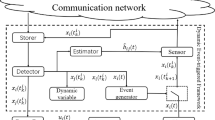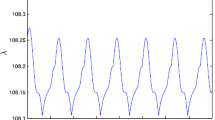Abstract
This paper is concerned with the observer-based prescribed-time synchronization and topology identification issue for complex networks of nonlinear impulsive piecewise-smooth systems (IPWSs), where the stabilizing and destabilizing impulses are considered simultaneously. A prescribed-time convergence principle is developed for nonlinear IPWSs on the basis of a power exponent function. A controller with time-varying feedback gains and a topology observer are designed to realize the prescribed-time synchronization and identification objective. By applying the Lyapunov stability theory and non-smooth analysis approach, the prescribed-time synchronization conditions are addressed, and the unknown topology is identified successfully through the topology observer. Finally, a simulation example is presented to show the effectiveness of the proposed strategy and the validity of the theoretical results.







Similar content being viewed by others
Data Availability
Not applicable.
References
Bao YG, Zhang YJ, Zhang BY et al (2021) Prescribed-time synchronization of coupled memristive neural networks with heterogeneous impulsive effects. Neural Process Lett 53:1615–1632
Bernardo M, Budd C, Champneys AR et al (2008) Piecewise-smooth dynamical systems: theory and applications. Springer Science & Business Media, New York
Cao YT, Zhao LH, Zhou QS et al (2023) Adaptive fixed-time output synchronization for complex dynamical networks with multi-weights. Neural Netw 163:28–39
Chen Y, Ye Q, Zhou DW et al (2015) Robust finite-time synchronization of chaotic parametrically excited pendulums with multiple uncertainties. 34th Chinese control conference (CCC). IEEE, pp 952-956
Chen J, Li XR, Wu XQ et al (2022) Prescribed-time synchronization of complex dynamical networks with and without time-varying delays. IEEE Trans Netw Sci Eng 9(6):4017–4027
Coraggio M, DeLellis P, Hogan SJ et al (2018) Synchronization of networks of piecewise-smooth systems. IEEE Control Syst Lett 2(4):653–658
Cortes J (2008) Discontinuous dynamical systems. IEEE Control Syst Mag 28(3):36–73
DeLellis P, Di Bernardo M, Liuzza D (2011) Synchronization of networked piecewise smooth systems. 2011 50th IEEE conference on decision and control and European control conference. IEEE, pp 3812–3817
DeLellis P, Di Bernardo M, Liuzza D (2015) Convergence and synchronization in heterogeneous networks of smooth and piecewise smooth systems. Automatica 56:1–11
Du FF, Lu JG (2022) Finite-time synchronization of fractional-order delayed fuzzy cellar neural networks with parameter uncertainties. IEEE Trans Fuzzy Syst 31(6):1769–1779
Filippov AF (2013) Differential equations with discontinuous righthand sides: control systems. Springer Science & Business Media, New York
Geng XT, Feng JW, Zhang Y et al (2023) Prespecified time synchronization of coupled dynamic network with impulsive effect via quantized control. IEEE transactions on control of network systems, pp 1–11. https://doi.org/10.1109/TCNS.2023.3272290
Goltsev AV, Dorogovtsev SN, Oliveira JG et al (2012) Localization and spreading of diseases in complex networks. Phys Rev Lett 109(12):128702
Guo T, Huang XB, Fang X et al (2023) Topology identification method of low-voltage substation. 2023 IEEE 12th international conference on communication systems and network technologies (CSNT). IEEE, pp 327–331
Huang ZH, Jiang GP, Wang XW (2021) Topology identification for multi-layer complex dynamical networks with coupling time delay. 2021 33rd Chinese control and decision conference (CCDC). IEEE, pp 4489–4496
Li ST, Gao SF, Wu JB et al (2020a) Research on topology identification of distribution network under the background of big data. 2020 IEEE 4th conference on energy internet and energy system integration (EI2). IEEE, pp 4294–4297
Li N, Wu XQ, Feng JW et al (2020b) Fixed-time synchronization of complex dynamical networks: a novel and economical mechanism. IEEE Trans Cybern 52(6):4430–4440
Li Y, Liu H, Li ZY (2020c) Topology identification and inner desynchronization of Hindmarsh–Rose neural networks. 2020 Chinese control and decision conference (CCDC). IEEE, pp 1642–1646
Liang T, Zhang WL, Yang DG (2023) Fixed-time synchronization of switched duplex networks with stochastic disturbances and limited communication. Commun Nonlinear Sci Numer Simul 121:107227
Liberzon D (2003) Switching in systems and control. Birkhäuser, Boston
Mei GF, Wu XQ, Wang YF et al (2017) Compressive-sensing-based structure identification for multilayer networks. IEEE Trans Cybern 48(2):754–764
Pagani GA, Aiello M (2013) The power grid as a complex network: a survey. Physica A Stat Mech Appl 392(11):2688–2700
Qin XL, Wang C, Li LX et al (2018) Finite-time modified projective synchronization of memristor-based neural network with multi-links and leakage delay. Chaos Solitons Fractals 116:302–315
Tang JJ, Wang YH, Liu F (2013) Characterizing traffic time series based on complex network theory. Physica A Stat Mech Appl 392(18):4192–4201
Tojtovska B, Jankovi S (2014) On some stability problems of impulsive stochastic Cohen–Grossberg neural networks with mixed time delays. Appl Math Comput 239:211–226
Tse CK (2003) Complex behavior of switching power converters. CRC Press, Boca Raton
Wang DS, Li LK (2023a) Fixed-time stability analysis of discontinuous impulsive systems. Commun Nonlinear Sci Numer Simul 120:107153
Wang DS, Li LK (2023b) Fixed-time synchronization of delayed memristive neural networks with impulsive effects via novel fixed-time stability theorem. Neural Netw 163:75–85
Wang CH, Zhao YL, Zhao SL et al (2017) Topology identification of general uncertain complex dynamic networks with time delay and noise perturbation based on generalized lag synchronization. 2017 4th International conference on information science and control engineering (ICISCE). IEEE, pp 1308–1312
Wang P, Wang DJ, Lü JH (2018) Controllability analysis of a gene network for Arabidopsis thaliana reveals characteristics of functional gene families. IEEE/ACM Trans Comput Biol Bioinform 16(3):912–924
Wu HQ, Shan CH (2009) Stability analysis for periodic solution of BAM neural networks with discontinuous neuron activations and impulses. Appl Math Model 33(6):2564–2574
Wu XQ, Wang WH, Zheng WX (2012) Inferring topologies of complex networks with hidden variables. Phys Rev E 86(4):046106
Wu YB, Guo HH, Xue L et al (2023) Prescribed-time synchronization of stochastic complex networks with high-gain coupling. IEEE Trans Circuits Syst II: Express Briefs 70(11):1–1
Xu LL, Liu XW (2022) Prescribed-Time synchronization for complex networks with additive coupling. In: 2022 37th Youth academic annual conference of Chinese Association of Automation (YAC). IEEE, pp 1527–1531
Xu YY, Chen Y, Lin Q (2017) Finite-time lag synchronization of two Chua’s circuit systems with time delay. 2017 36th Chinese control conference (CCC). IEEE, pp 949–954
Yang XS, Lu JQ (2015) Finite-time synchronization of coupled networks with Markovian topology and impulsive effects. IEEE Trans Autom Control 61(8):2256–2261
Yang XS, Lam J, Ho D et al (2017) Fixed-time synchronization of complex networks with impulsive effects via nonchattering control. IEEE Trans Autom Control 62(11):5511–5521
Yu DC, Righero M, Kocarev L (2006) Estimating topology of networks. Phys Rev Lett 97(18):188701
Yuan WY, Shi SL, Ma YC (2022) Fixed-time stochastic synchronization of impulsive multi-weighted complex dynamical networks with non-chattering control. Neurocomputing 475:53–68
Zavlanos MM, Julius AA, Boyd SP et al (2008) Identification of stable genetic networks using convex programming. 2008 American Control Conference. IEEE, pp 2755–2760
Zhang ZQ, Cao JD (2018) Novel finite-time synchronization criteria for inertial neural networks with time delays via integral inequality method. IEEE Trans Neural Netw Learn Syst 30(5):1476–1485
Zhao H, Li LX, Peng HP et al (2017) Finite-time topology identification and stochastic synchronization of complex network with multiple time delays. Neurocomputing 219:39–49
Funding
This work was supported by the Natural Science Foundation of China (No. 12171416) and the Key Project of Natural Science Foundation of China (No. 61833005).
Author information
Authors and Affiliations
Corresponding author
Ethics declarations
Conflict of interest
The authors declare that they have no known competing financial interests or personal relationships that could have appeared to influence the work reported in this paper.
Additional information
Publisher's Note
Springer Nature remains neutral with regard to jurisdictional claims in published maps and institutional affiliations.
Rights and permissions
Springer Nature or its licensor (e.g. a society or other partner) holds exclusive rights to this article under a publishing agreement with the author(s) or other rightsholder(s); author self-archiving of the accepted manuscript version of this article is solely governed by the terms of such publishing agreement and applicable law.
About this article
Cite this article
Hou, X., Wu, H. & Cao, J. Observer-based prescribed-time synchronization and topology identification for complex networks of piecewise-smooth systems with hybrid impulses. Comp. Appl. Math. 43, 180 (2024). https://doi.org/10.1007/s40314-024-02701-x
Received:
Revised:
Accepted:
Published:
DOI: https://doi.org/10.1007/s40314-024-02701-x
Keywords
- Piecewise-smooth systems
- Hybrid impulses
- Complex networks
- Topology identification
- Prescribed-time synchronization




